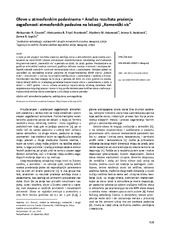Приказ основних података о документу
Lead in atmospheric precipitation: analysis of atmospheric precipitation pollution monitoring data for location kamenicki vis, Serbia
| dc.creator | Ćosović, Aleksandar | |
| dc.creator | Tripić-Stanković, Aleksandra B. | |
| dc.creator | Adamović, Vladimir M. | |
| dc.creator | Avdalović, Jelena S. | |
| dc.creator | Lopičić, Zorica | |
| dc.date.accessioned | 2021-03-10T12:11:19Z | |
| dc.date.available | 2021-03-10T12:11:19Z | |
| dc.date.issued | 2013 | |
| dc.identifier.issn | 0367-598X | |
| dc.identifier.uri | http://TechnoRep.tmf.bg.ac.rs/handle/123456789/2457 | |
| dc.description.abstract | In this paper, an overview of data collected during monitoring of lead content in atmospheric precipitation on GAW/EMEP (Global Atmosphere Watch/European Monitoring and Evaluation Programme) station "KameniCKI Vis", Serbia from 2000 to 2010 is given. Annual arithmetic mean concentrations, weighted arithmetic mean concentrations, and median of week samples are presented. Obtained data was compared with results of analysis of atmospheric precipitation collected on experimental EMEP station "Zeleno brdo", Serbia and discussed in the scope of European average levels of lead content in precipitation and air. Significant increase of average annual lead content in precipitation was observed in 2003 and 2007. The observed peaks cannot be seen on average European trends, thus leading to the conclusion that the recorded increases are characteristic for the local region. In order to further discuss the nature and direction of possible sources of detected lead pollution, a short analysis of lead emission data was performed. An effort was made to gather data from the countries that lay in directions from which dominant winds blow, as well as for Serbia. For this purpose, total national emissions from LRTAP Convention emission inventory report and EMEP emission inventory were used, as well as data published by relevant national authorities. According to these emission levels, the majority of the surrounding countries couldn't have contributed much to the recorded increases of lead content in precipitation. However, several possible sources were revealed. In all studied countries, emission levels steadily dropped during the analyzed period, whereas only for Serbia a different trend was observed. The presented data leads to the conclusion that the recorded increase of lead content in precipitation in 2003 probably originates from trans-boundary contributions, while increases in 2007 and onwards may come from Serbia's own emissions. | en |
| dc.publisher | Savez hemijskih inženjera, Beograd | |
| dc.relation | info:eu-repo/grantAgreement/MESTD/Technological Development (TD or TR)/34023/RS// | |
| dc.rights | openAccess | |
| dc.rights.uri | https://creativecommons.org/licenses/by-nc-nd/4.0/ | |
| dc.source | Hemijska industrija | |
| dc.subject | Atmospheric precipitation | en |
| dc.subject | Lead content | en |
| dc.subject | Air pollution | en |
| dc.title | Lead in atmospheric precipitation: analysis of atmospheric precipitation pollution monitoring data for location kamenicki vis, Serbia | en |
| dc.type | article | |
| dc.rights.license | BY-NC-ND | |
| dc.citation.epage | 534 | |
| dc.citation.issue | 3 | |
| dc.citation.other | 67(3): 525-534 | |
| dc.citation.rank | M23 | |
| dc.citation.spage | 525 | |
| dc.citation.volume | 67 | |
| dc.identifier.doi | 10.2298/HEMIND120622118C | |
| dc.identifier.fulltext | http://TechnoRep.tmf.bg.ac.rs/bitstream/id/683/2454.pdf | |
| dc.identifier.scopus | 2-s2.0-84879717973 | |
| dc.identifier.wos | 000324565900014 | |
| dc.type.version | publishedVersion |

